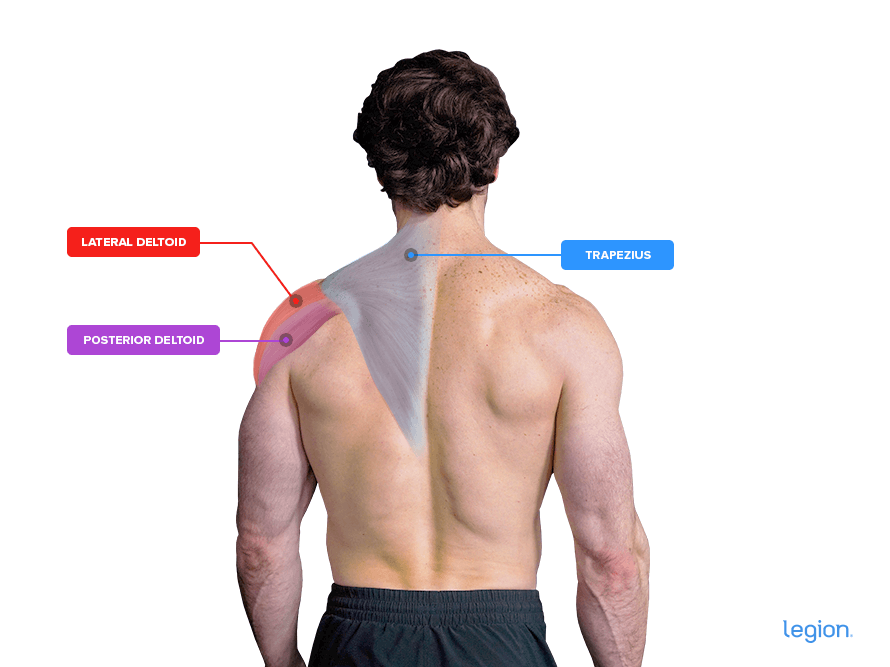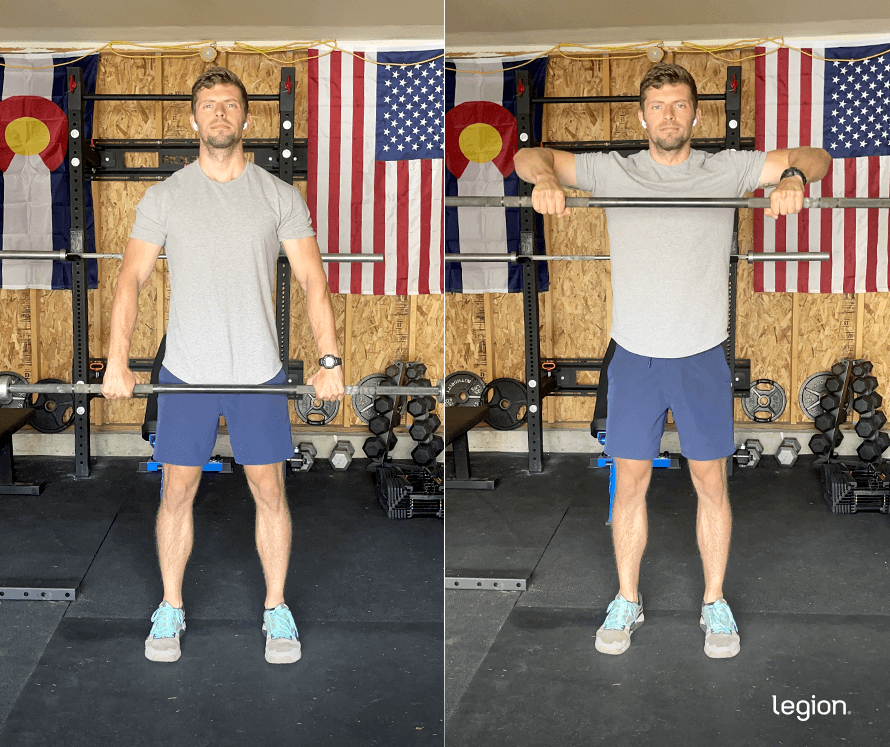The upright row is an upper-body exercise that primarily trains your shoulders.
Despite being an effective exercise, some avoid the upright row, believing it carries a high risk of injury.
In truth, performing the upright row with poor form may aggravate your shoulders. Do it correctly, however, and it’s perfectly safe.
In this article, you’ll learn what the upright row is, why it’s beneficial, how to perform it using proper form, the best upright row alternatives, and more.
Table of Contents
+
What Is An Upright Row?
The upright row is a shoulder exercise that involves pulling a weight from hip height toward your chin.
The two most common variations are the barbell upright row and dumbbell upright row.
While both train the same shoulder muscles, most people prefer the barbell upright row exercise because it requires less coordination and allows you to lift heavier weights, which is generally better for muscle growth. As such, we’ll focus on the barbell upright row in this article.
Upright Row: Benefits
Many weightlifters train their side and rear delts less than their front delts.
Over time, this can lead to strength and size imbalances between the front, side, and back of the shoulders, which may blight your upper-body aesthetics and increase your risk of injury.
Research shows that the upright barbell row effectively trains the side and rear delts, making it ideal for ensuring your shoulders develop proportionally and remain healthy.
Additionally, it trains your upper traps. When these muscles are well developed, they help “frame” your upper body and aesthetically connect your neck to your shoulders.
Another potential benefit is that it mimics movements we make in everyday life (lifting grocery bags onto a counter, for example). This means you can use it to strengthen the muscles involved in these movements, which may make day-to-day activities easier.
Upright Row: Muscles Worked
The main muscles worked by the upright barbell row are the . . .
- Lateral (side) deltoid
- Posterior (rear) deltoid
- Trapezius
It also works your biceps to a lesser degree.
Here’s how the main muscles worked by the upright row look on your body:

How to Do an Upright Row
The best way to learn how to do an upright row is to split the exercise into three parts: set up, row, and descend.

Model: Ryan Koziol
1. Set up
Stand with your feet shoulder-width apart and grip a loaded barbell with an overhand grip (palms facing your body) just outside shoulder width.
Let your arms hang straight down so that the barbell is in front of your thighs.
2. Row
While keeping the bar as close to your body as possible, lift the bar toward the ceiling by driving your elbows out to your sides and up.
Continue lifting until your upper arms are parallel to the floor, keeping your elbows higher than your forearms throughout the movement.
Don’t lift the weight beyond that point at which your upper arms are parallel to the floor, as doing so can increase your risk of injury.
3. Descend
Reverse the movement and return to the starting position. This mirrors what you did during the row.
Don’t let the barbell fall back to the starting position or try to lower it slowly—the entire descent should be controlled but only take about a second.
The Best Upright Row Alternatives
1. Dumbbell Upright Row
Using dumbbells rather than a barbell allows your wrists to move more freely, which can be helpful for people with mobility issues or injuries. The dumbbell variation is also a viable alternative if you train at home or while traveling and don’t have access to a barbell.
2. Cable Upright Row
Performing an upright cable row on a cable machine keeps constant tension on your muscles throughout each rep, which is beneficial for muscle growth.
You can also have more freedom to choose an attachment that feels most comfortable, like EZ-curl bar or cable rope upright rows.
3. Wide-Grip Upright Row
Performing the exercise with your hands two times wider than shoulder-width apart emphasizes the side delts and traps more than performing it with a narrower grip, making the wide-grip variation an excellent option for those looking to maximize shoulder and upper-back development.
That said, some people find taking a wide grip aggravates their shoulders, which means it may not be suitable for this with a history of shoulder issues.
4. EZ-Bar Upright Row
The EZ-bar upright row is almost identical to the regular upright row. The only difference is you use an EZ-curl bar instead of a straight barbell.
As such, you can think of the EZ-bar and barbell upright rows as interchangeable—do whichever you have equipment for.
5. Smith Machine Upright Row
The Smith machine upright is similar to the barbell variation, though it probably isn’t as effective at developing your upper-body muscles. That said, it’s a workable alternative if you don’t have access to a barbell, if you’re new to weightlifting, or you simply don’t want to do the barbell version.
FAQ #1: Is the plate upright row an effective upright row alternative?
No.
Plate upright rows are ineffective for three reasons:
- Plates max out at 45 pounds, limiting the amount you can progressively overload your muscles.
- Since gripping a plate is awkward, you may have to end a set of plate upright rows when your grip gives out rather than when your shoulder muscles are fully stimulated.
- Many plates don’t have a handle, and on those that do, the handle is often small, forcing you to take a grip with your hands close together. This decreases how much your shoulders and traps contribute to the exercise and, for some, puts stress on the wrists, making the movement uncomfortable.
It’s a viable option if nothing else is available, but it shouldn’t be your first choice.
FAQ #2: What does the upright row work?
The upright row trains your side and rear delts and traps. It also trains your biceps to a lesser degree.
FAQ #3: Are upright rows bad for your shoulders?
It depends.
Many weightlifters shun the upright barbell row because they believe it’s bad for your shoulder joints.
They think this because it requires you to perform shoulder internal rotation (rotating your upper arms so your elbows point directly out to the sides) while raising your upper arm above shoulder height.
The issue is that doing this may cause the bones in the shoulder joint to “rub” against the rotator cuff muscles and tendons, causing pain and inflammation.
Research shows, however, that the upright row is perfectly safe, provided you keep the barbell close to your body throughout the full range of motion and don’t lift the weight beyond the point at which your upper arms are parallel to the floor.
Scientific References +
- Page, Phil. “Shoulder Muscle Imbalance and Subacromial Impingement Syndrome in Overhead Athletes.” International Journal of Sports Physical Therapy, vol. 6, no. 1, 2011, pp. 51–8, www.ncbi.nlm.nih.gov/pmc/articles/PMC3105366/.
- McAllister, Matthew J., et al. “Effect of Grip Width on Electromyographic Activity during the Upright Row.” The Journal of Strength & Conditioning Research, vol. 27, no. 1, 1 Jan. 2013, pp. 181–187, journals.lww.com/nsca-jscr/Fulltext/2013/01000/Effect_of_Grip_Width_on_Electromyographic_Activity.25.aspx, https://doi.org/10.1519/JSC.0b013e31824f23ad. Accessed 28 Apr. 2020.
- Schoenfeld, Brad J , et al. The Upright Row: Implications for Preventing Subacromial Impingement. Oct. 2011, pp. 33(5):25-28, www.researchgate.net/publication/232210633_The_Upright_Row_Implications_for_Preventing_Subacromial_Impingement, https://doi.org/10.1519/SSC.0b013e31822ec3e3. Accessed Oct. 2011.
- Schwanbeck, Shane, et al. “A Comparison of Free Weight Squat to Smith Machine Squat Using Electromyography.” Journal of Strength and Conditioning Research, vol. 23, no. 9, Dec. 2009, pp. 2588–2591, https://doi.org/10.1519/jsc.0b013e3181b1b181.










